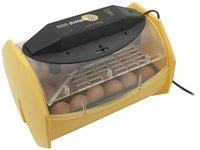I bought this thing mostly just to use as a hatcher. I have an Rcom that I love that I incubate with. It worked fine for that purpose for a while. Although it is incredibly difficult to clean, because there are too many nooks and crannies that you can't get to.
I did end up getting a turner for it, and that had to be replaced under warranty. I really haven't used this thing much at all, and it has been stored in the house for the entire time I've had it (3 years, I believe). I had to replace the fan a month or so ago because it was noisy and clearly going bad. Then, just today, I cleaned it and then plugged it back in (it had been off for a few days), and it won't heat. Brinsea doesn't even sell heating units for this thing on their website, so I guess I'm just out several hundred dollars (and potentially eggs that I have no where to move). I can guarantee I won't be replacing it with another Brinsea. Maybe it'll make a good doorstop?
I did end up getting a turner for it, and that had to be replaced under warranty. I really haven't used this thing much at all, and it has been stored in the house for the entire time I've had it (3 years, I believe). I had to replace the fan a month or so ago because it was noisy and clearly going bad. Then, just today, I cleaned it and then plugged it back in (it had been off for a few days), and it won't heat. Brinsea doesn't even sell heating units for this thing on their website, so I guess I'm just out several hundred dollars (and potentially eggs that I have no where to move). I can guarantee I won't be replacing it with another Brinsea. Maybe it'll make a good doorstop?



